
Summer is a great time to escape the hustle and bustle of busy streets and head for the trails in search of scenic routes, peaceful surroundings, and mixed terrain. It also gives you an excellent reason to plan a trail running destination vacation. Another benefit of trail running? It’s affordable, accessible, and requires minimal equipment to get started (after you purchase a good pair of shoes, of course).
That said, finding the best trail running shoes to fit your feet (whether flat or arched), skill level, and goals can feel a bit overwhelming. But that’s where we come in—we've rounded up the 10 best options, including everything from lightweight and cushioning options to budget-friendly finds.
So, if you're ready to get serious about trail running, read on to learn key factors for choosing the best trail running shoes, details about the ACTIVE Reviews Team's top picks, and answers to commonly asked questions about trail running shoes.
Why Trust Us?
ACTIVE.com's editorial team relies on the knowledge and experience of fitness and wellness experts including competitive athletes, coaches, physical therapists, nutritionists, and certified trainers. This helps us ensure the products we feature are of the highest standard. Collectively, the team has spent countless hours researching equipment, gear, and recovery tools in order to create the most accurate, authentic content for our readers. Customer satisfaction is also a key part of our review process, which is why we only feature products that are highly rated. More importantly, each member of our team is a fitness enthusiast.
The Best Trail Running Shoes — Our Top Picks
By clicking on the product links in this article, we may receive a commission fee at no cost to you, the reader. Sponsorships and affiliate commissions help support our research so we can help you find the best products. Read full affiliate disclosure Here.
- Best Overall Trail Running Shoes: Hoka Speedgoat 5
- Best Lightweight Trail Running Shoes: Salomon Sense Ride 4 GoreTex Invisible Fit
- Best Trail Running Shoes for Men: adidas Men's Terrex Agravic Flow 2 Trail
- Best Trail Running Shoes for Women: adidas Women's Terrex Agravic Flow 2 Trail
- Best Waterproof Trail Running Shoes: Brooks Cascadia 16 GTX Running Shoe
- Best All-Weather Trail Running Shoes: Salomon Speedcross 5
- Best Trail Running Shoes for Hiking: New Balance Fresh Foam x Hierro v7
- Best Stability Trail Running Shoes: La Sportiva Bushido II Trail Running Shoe
- Best Budget Trail Running Shoes: Under Armour Charged Bandit TR 2
Best Overall Trail Running Shoes - Hoka Speedgoat 5
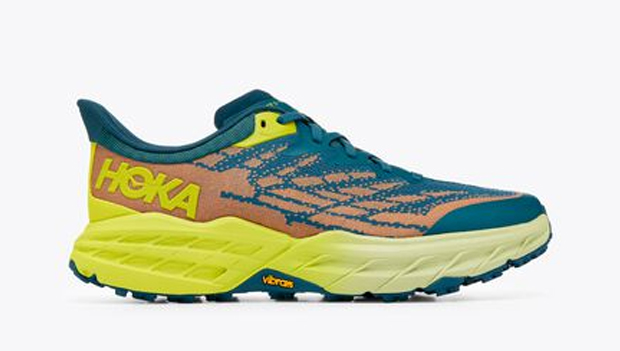
SPECS
- Shoe type: Rugged trail; light trail
- Weight: 10.3 oz.
- Cushioning: Balanced; maximum
- Heel-to-toe drop: 4mm
- Waterproof: Yes
Hoka shoes are known for their cloud-like cushioning, comfortable fit, and technical features. The brand also does an excellent job producing shoes for various surfaces and running needs. The Hoka Speedgoat 5 has just the right amount of cushioning for trail runners looking for a soft ride without compromising responsiveness.
Designed for light to rugged conditions, the Speedgoat 5 features a Vibram Megagrip rubber on the outsole with traction lugs for an enhanced grip. Up front, it has a protective toe cap to shield your toes from rocks and trail debris—a nice feature if you run on rugged paths. Plus, it’s lightweight, coming in at around just 10.3 ounces.
What We Like
- Balanced cushioning provides a soft but responsive ride
- Lightweight
- Excellent traction for rough terrain
What We Don't Like
- Pricier than other trail shoes
- Narrow fit and feel
Best Lightweight Trail Running Shoes - Salomon Sense Ride 4 GoreTex Invisible Fit
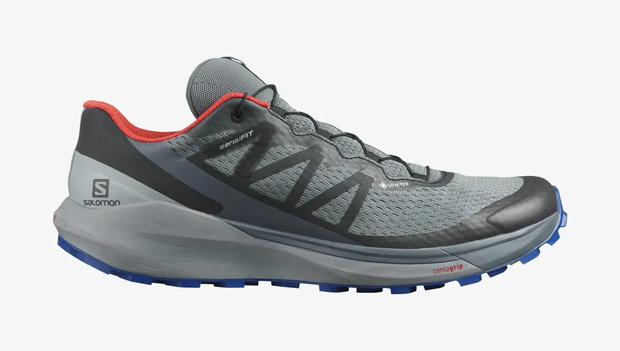
SPECS
- Shoe type: Mixed terrain
- Weight: 10.79 oz.
- Cushioning: Moderate
- Heel-to-toe drop: 8 mm
- Waterproof: Yes, GORE-TEX
Finding a lightweight, durable trail running shoe is no easy feat. Fortunately, the Salomon Sense Ride 4 shoes feel light on your feet and provide a responsive ride even on some of the toughest terrains. Moderate cushioning makes the Sense Ride ideal for most runners. We also like how the shoes feature a combination of foams that reduce vibration and decrease muscle fatigue.
In addition to being lightweight, the Salomon Sense Ride 4’s are also resistant to unpredictable weather and rain. Plus, the All Terrain Contagrip allows you to feel confident on all kinds of uneven surfaces.
What We Like
- Lightweight
- Good for mixed terrain
- Combination of foams provides comfort and a responsive ride
- GORE-TEX waterproof membrane
What We Don't Like
- May be too narrow for wide feet
- No rock plate
BUY: Salomon Sense Ride 4 GoreTex Invisible Fit
Best Trail Running Shoes for Men - adidas Men's Terrex Agravic Flow 2 Trail
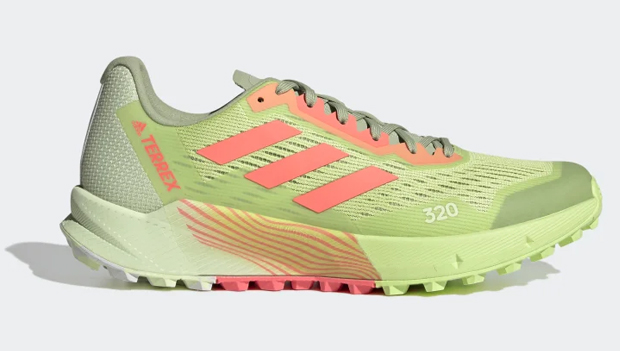
SPECS
- Shoe type: Rugged trail; light trail
- Weight: 11.3 oz. (size 9)
- Cushioning: Moderate
- Heel-to-toe drop: 8mm
- Waterproof: Mudguard protection; GORE-TEX lining
It's no surprise that the adidas Terrex Agravic Flow 2 is our top pick for the best trail running shoes for men. We like this shoe for the same reasons we chose it as the best trail running shoe for women. It boasts several great features like rock protection, stability, and a GORE-TEX lining to keep your feet dry. Plus, the Continental rubber outsole gives you the grip and traction you need on even the most rugged trails.
Like the women’s version, the adidas Terrex Agravic Flow 2 for men is a bit on the heavy side, which may be a deal-breaker if you go out on long trail runs. It also fits a bit stiff with a rigid feel that might not work for runners wanting a soft ride.
What We Like
- Affordable compared to other trail shoes
- Made with recycled products
- Adequate stability for rough and technical terrain
What We Don't Like
- Heavy shoe
- Stiff and rigid feel
BUY: adidas Men’s Terrex Agravic Flow 2 Trail
Best Trail Running Shoes for Women - adidas Women's Terrex Agravic Flow 2 Trail

SPECS
- Shoe type: Rugged trail; light trail
- Weight: 11.3 oz. (size 10.5)
- Cushioning: Moderate
- Heel-to-toe drop: 8mm
- Waterproof: Mudguard protection; GORE-TEX lining
Comfortable fit, superior protection, and maximum breathability are key features of a trail running shoe. That’s why the adidas Terrex Agravic Flow 2 is our top pick for the best trail running shoes for women.
Designed for various trail conditions, frequent use, versatility, and performance, the Terrex Agravic Flow 2 is a moderately-priced show with several technical features. The GORE-TEX breathable membrane helps keep your feet dry in wet conditions, while the Continental Rubber outsole provides a superior grip on a wide range of terrain.
What We Like
- Affordable compared to other trail shoes
- Made with recycled products
- Adequate stability for rough and technical terrain
What We Don't Like
- Stiff and rigid feel
BUY: adidas Women's Terrex Agravic Flow 2 Trail
Best Waterproof Trail Running Shoes - Brooks Cascadia 16 GTX Running Shoe
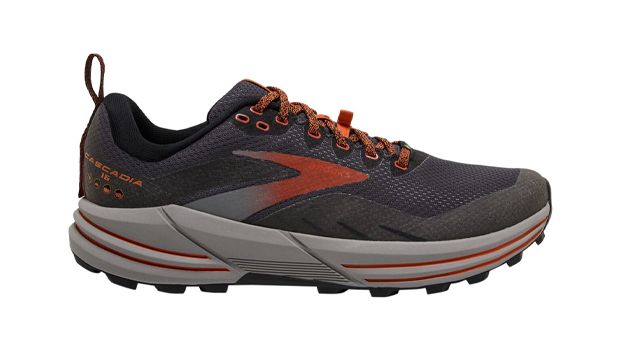
SPECS
- Shoe type: All-terrain
- Weight: 11.5 oz.
- Cushioning: Extra cushioning plus protection
- Heel-to-toe drop: 8mm
- Waterproof: Yes; GORE-TEX
Wet terrain is no match for the Brooks Cascadia 16 GTX trail running shoe. This versatile and well-cushioned shoe comes equipped with a waterproof GORE-TEX membrane for all-day comfort through puddles and other wet conditions. It’s also an excellent all-around shoe for runners wanting a cushioned midsole to use on medium to difficult terrain. Plus, the Cascadia 16 GTX features a flexible Ballistic Rock Shield for added protection when running on bumpy terrain. And, the Trail Track rubber outsole ensures you’ll have traction on dirt, roots, and rocks.
However, we want to note that the fit is a bit on the stiff side, which is common with waterproof membranes. And at 11.5 ounces, the shoe is heavier than other trail running shoes so keep that in mind if weight is a concern.
What We Like
- Supreme cushioning
- GORE-TEX waterproof membrane
- Good for everyday trail runs
- Powerful rock plate
What We Don't Like
- Heavier than other trail shoes
- Increased stability results in lack of ground feel
- Stiff fit
BUY: Brooks Cascadia 16 GTX Running Shoe
Best All-Weather Trail Running Shoes - Salomon Speedcross 5

SPECS
- Shoe type: Muddy and soft terrain
- Weight: 11.6 oz.
- Cushioning: Moderate
- Heel-to-toe drop: 10mm
- Waterproof: None
Trail runners rarely shy away from unpredictable weather. Fortunately, the right gear can keep you going through even the roughest conditions. The Salomon Speedcross 5 is designed for maximum grip on muddy areas, rocky surfaces, soft trails, and even snowy or icy sections. They get their excellent grip from the Mud Contagrip, which features larger lugs with more space, allowing for better braking grip and push-off.
A molded OrthoLite sock liner hugs the contours of your foot and provides superior cushioning. It also adds to the durability and breathability of the shoe. And, the Quicklace system ensures easy on and off.
What We Like
- Affordable
- OrthoLife insole provides superior cushioning
- Maximum grip is ideal for muddy and soft surface trails
- Side vents provide good breathability
What We Don't Like
- Steeper heel-to-toe drop than other trail shoes
- No rock plate in midsole
Best Trail Running Shoes for Hiking - New Balance Fresh Foam X Hierro v7
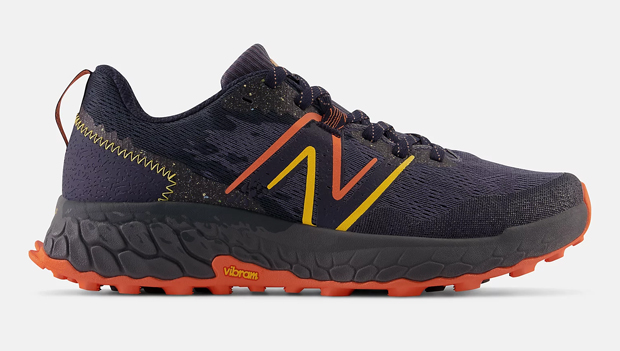
SPECS
- Shoe type: Light trail
- Weight: 10.6 oz.
- Cushioning: Moderate
- Heel-to-toe drop: 8mm
- Waterproof: N/A
Hiking and trail running both require a shoe that can handle mixed terrain and varying conditions. That’s why we chose the New Balance Fresh Foam Hierro v7 as the best trail running shoes for hiking. The Hierro v7 is well-suited for runners and hikers who spend time on light to moderately technical trails and want a soft, responsive ride.
These shoes feature a Vibram Megagrip outsole that increases durability and traction on wet, muddy, dry, and rough terrain. The Vibram Megagrip also creates a protective shell around the Fresh Foam X cushioning. We also like their lightweight feel, making these shoes ideal for long distances and high-frequency training.
What We Like
- Affordable
- Some parts are made with recycled materials
- Outsole provides durability and traction on rough terrain
What We Don't Like
- Minimal cushioning
- Colors and aesthetics are not as appealing as other trail shoes
BUY: New Balance Fresh Foam x Hierro v7
Best Stability Trail Running Shoes - La Sportiva Bushido II Trail Running Shoe

SPECS
- Shoe type: Rugged trail; light trail
- Weight: 10.5 oz.
- Cushioning: Light/moderate
- Heel-to-toe drop: 6mm
- Waterproof: N/A
Stability is a critical component of any running shoe, especially a trail running shoe. That’s why we chose the La Sportiva Bushido II as our best stability trail running shoe. Designed for all types of terrain, the Bushido II features STB stabilization technology on the side of uppers for maximum control while navigating highly technical trails. They also have an extra grippy outsole to help with traction in wet and dry conditions and an EVA rock plate to minimize the "ouch" factor when you step on rocks or roots.
Compression-molded EVA foam lines the midsole for moderate cushioning. And, we also like the weight—only 10.5 ounces.
What We Like
- Lighter than other trail shoes
- Very supportive and stable ride
- Rock plate adds protection from rough terrain
- Excellent traction on mixed terrain surfaces
- Sturdy rubber toe cap
What We Don't Like
- Narrow fit and feel
- Doesn’t breathe well; might not be ideal for warm climates
BUY: La Sportiva Bushido II Trail Running Shoes
Best Budget Trail Running Shoe - Under Armour Charged Bandit TR 2

SPECS
- Shoe type: Light trail
- Weight: 11 oz.
- Cushioning: Moderate
- Heel-to-toe drop: 8mm
- Waterproof: N/A
You don’t need to spend a fortune to get a quality trail running shoe. Coming in at under $100, the Under Armour Charged Bandit TR 2 trail running shoe is affordable, comfortable, and built for withstanding all kinds of terrain.
The Charged Bandit TR2 features an 8mm heel-to-toe drop, compression-molded foam for a responsive ride, a molded sock liner for added comfort, and a durable outsole for traction in wet and dry conditions. In addition, the upper has Heathered Mesh for better foot movement and breathability.
What We Like
- Budget-friendly price
- Good for light trail runs and hiking
- Excellent shoe for entry-level trail running
What We Don't Like
- May be too basic of a design for experienced trail runners
- Lacks long-term durability of other trail shoes
BUY: Under Armour Charged Bandit TR 2
Why Trail Running?
Trees, mountains, wildlife, rivers, and wide-open spaces are just a few reasons people gravitate towards trail running. Not to mention the challenge of navigating unpredictable terrain and conditions can help distract your mind from daily stressors.
Trail running is also a great way to challenge your muscles and cardiovascular system while also improving your balance and strengthening your joints. The best part? Trail running offers numerous benefits for both new and experienced runners so you can enjoy this activity no matter what fitness level you’re at.
The Benefits of Trail Running
- Trail running challenges your core: Rugged terrain, unstable surfaces, hills, turns, and narrow paths all make for a challenging core workout. Your core includes the rectus abdominis, transverse abdominis, internal and external obliques, and erector spinae muscles. These muscles help you stay upright while navigating tricky terrain. They also assist with moving you forward, taking sharp turns, and propelling you uphill.
- Trail running builds your leg muscles: Trails generally work your lower body muscles and joints more than running on a road or a treadmill. Why? Because you’re moving all over the path, trying to dodge roots, mud, rocks, and other obstacles. Plus, trails often have varying inclines requiring explosive power in your legs. Go uphill, and you’ll recruit the glutes, hamstrings, and calves. Reverse directions, and you’ll feel the burn in your quads as you head down the hill.
- Trail running boosts endurance and anaerobic power: Aerobic exercise like walking and jogging improves your endurance, making it easier to add mileage over time. Throw in some short and long hills, which are standard on most trail routes, and you’ll also boost your anaerobic system.
- Trail running immerses you in nature: Getting off the street and away from cars, buses, and other industrial areas decreases your exposure to air pollution, which can help you breathe easier while running. You’ll also be surrounded by trees and other vegetation that provide shade during hot weather and protect you from wind and rain during the winter.
A Quick Note About Getting Started
If you’re new to trail running, consider starting with fewer miles and easier terrain. Also, give yourself time to learn the nuances of maneuvering around roots, rocks, and mud puddles.
One easy way to do this is to walk the trails before you pick up the pace. This allows you to check out the conditions and make a note of any hazards you want to avoid.
What to Look for in Trail Running Shoes
Design and build
Trail running shoes take a beating. And while your shoes don’t have to be built to withstand everything, you still need a durable shoe that can handle rough terrains, wet ground surfaces, and unpredictable conditions.
For example, the outer sole on a trail shoe has larger treads or lugs and a softer rubber material to adapt to mixed terrain. Moving to the midsole, you'll notice a firmer build for more stability, which equates to a stiffer fit and feel.
Trail shoes are also highly technical, so consider working with a running shoe or outdoor expert who can fit you for a shoe built to match your needs.
Heel-to-toe drop
Heel-to-toe drop or "drop" is the height difference between the heel of the shoe and the toe box. The average heel-to-toe drop in trail running shoes ranges from 4mm to 8mm, but some, like the Salomon Speedcross 5, go up to 10mm.
Why does this matter? The lower the heel drop, the more likely you’ll have a midfoot or forefoot strike. A higher heel drop is associated with heel striking, which may increase your risk of hip and knee pain. However, it also comes with more cushioning in the heel compared to a low drop.
A running specialist can analyze your stride and find the best trail running shoe to match your heel-to-toe drop.
Rock plate and toe guards
While not a feature in all trail running shoes, the rock plate is a nice addition, especially if you run on rugged trails or take your journey off-road. A rock plate is a firm material embedded between the midsole and outsole. Its main job is to protect your feet from sharp rocks and other irregular-shaped objects on the trail.
Another feature on some of the best trail running shoes is a toe cap or guard, which protects your toes if you kick a rock or root. Rock plates and toe guards are more common on rugged trail shoes rather than shoes designed for light trail running.
Cushioning
The amount of cushion right for you comes down to personal preference. Some people like the max, while others like minimal cushioning, so they can still feel the ground while running. However, because trails are more rugged than the road, you may want to consider a shoe with more cushioning than your current running shoe.
Grip and traction
Excellent grip and traction are key when hitting the trails. Fortunately, the best trail running shoes have features that offer this support. For example, the outsole should have deep, multi-directional lugs for great traction in mud and soft soil. Some of the more rugged trail shoes even have grippy rubber for extra traction on rocks and roots. They may also have internal shanks, making them stiffer to keep you more stable on difficult trails.
Waterproof features
Only a few of the best trail running shoes offer waterproof features like a GORE-TEX waterproof membrane. But a waterproof shoe is worth considering if you do most of your trail running in wet climates or muddy conditions. That said, shoes that keep your feet dry are not always the most breathable so be sure to decide which feature is most useful to you.
FAQs About Trail Running Shoes
Is it okay to wear trail running shoes on the road?
Yes, you can wear trail running shoes on the road. Many people enjoy the added stability and protection a trail shoe provides. But, keep in mind that they are heavier than a running shoe.
Additionally, the pavement causes extra wear and tear on the rubber outsole, leading to less traction when trail running. That said, some brands offer a hybrid model designed for trail and road use, which is ideal for runners who prefer routes that combine light trails with road surfaces.
Are trail running shoes durable?
In general, trail running shoes are more durable than your average running shoe, and built to handle mixed terrain and rough conditions.
However, the softer grippy underfoot breaks down over time, leading to less traction. You can slow this excess wear and tear by keeping your shoes on the trail and off the pavement. Like running shoes, trail shoes tend to lose their cushioning over time and need to be replaced.
You can always take your current trail shoes to a shoe expert to determine if it’s time for a new pair.
Can you wear trail running shoes for everyday use?
While you can wear trail running shoes for everyday use, many serious trail runners choose to save their shoes for training. This helps the shoe last longer and maintains the structure and stability needed when pounding the heavy terrain.
Also keep in mind that a trail shoe is typically heavier, more rigid, and doesn’t breathe as well as a cross trainer or running shoe. So, they might not be ideal for all-day wear.
What is the difference between a running shoe and a trail running shoe?
A standard running shoe is not built for rugged terrain, wet conditions, or kicking rocks while cruising through the woods. Trail shoes have stickier rubber or outsole lugs for maximum traction.
Most trail shoes also have a rock plate to protect against roots, rocks, and other objects that could harm your feet. They’re also stiffer, more durable, and heavier than running shoes. Investing in a trail running shoe means you’ll get more protection, durability, and traction.
Get ACTIVE on the Go


Couch to 5K®
The best way to get new runners off the couch and across the finish line of their first 5K.
Available for iOS | Android



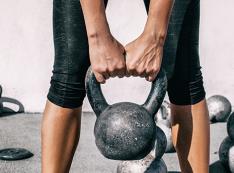
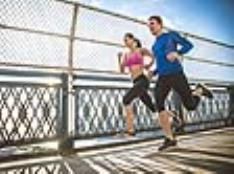


Discuss This Article